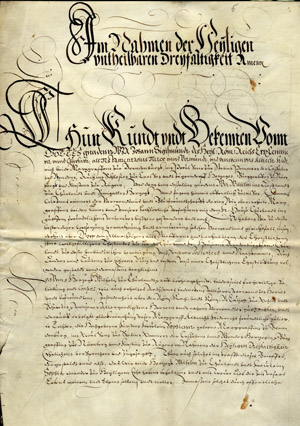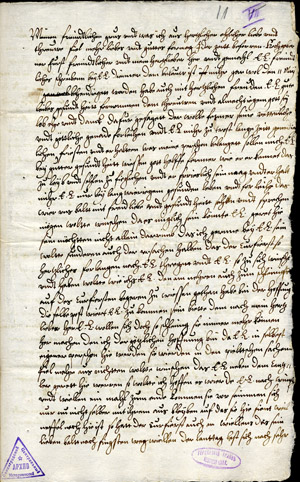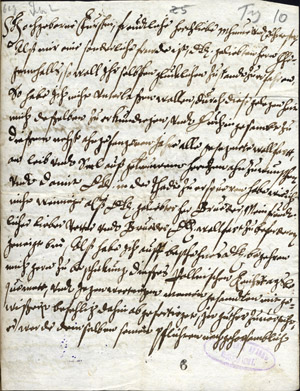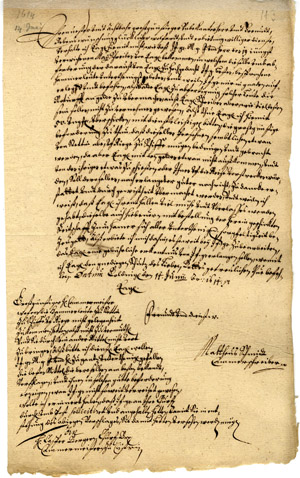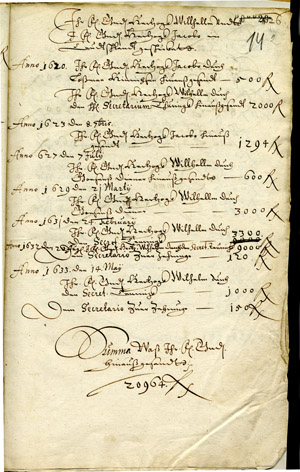Duke William (15741640) and
Duchess Sophie (15821610)
During the early 1590s William studied at Rostock University. In 1595, having taken over from Frederick as ruler of Courland, which he had inherited, he strove to augment his power as duke, which soon brought him into conflict with the nobles. In 16051607 William travelled extensively. After returning to Courland he asked for the hand in marriage of Sophie, the daughter of Albrecht Frederick (15681618), Duke of Prussia, and took part in the fighting against Swedish forces that had landed at Riga. Although the wedding took place in Königsberg in early 1609, he brought his wife to Goldingen/Kuldīga only several months later. Their happiness did not last long: Sophie died less than four weeks after the birth of Prince James (Jakob), on 24 November 1610. After the death of Sophie, William did not seek to remarry, but instead turned to administrative matters. However, his relations with the nobles went from bad to worse. In 1615 the nobles accused William of plotting the murder of the Nolde brothers, as a result of which Sigismund III of Poland removed him from the throne in 1616. William was forced to go into exile and seek the assistance of his relatives and friends in regaining the throne. He regained the title of duke only after the death of Sigismund III, in 1632, and only on the condition that he would never return to the duchy. Otherwise Poland-Lithuania refused to recognise Prince James as heir to the duchy.
1. Duchess Sophie. 1606. Painting by Daniel Rose. Photo from the collections of Rundāle Palace Museum.
2. Marriage agreement between William and Sophie. Königsberg, 5 January 1609. Parchment. Excerpt. LVVA, Collection 554, Inventory 1, File 56.
As in other documents of this kind, considerable attention is given in this agreement to provision for the duchess in the event of her husband's death. Wilialm granted Sophie as her dower the manors of Tuckum/Tukums and Kandau/Kandava, together with the surrounding districts.
3. Letter from Duchess Sophie to her husband, written in her own hand. Königsberg, 15 May 1609. LVVA, Collection 554, Inventory 1, File 74.
Only a very small number of documents relating to Duchess Sophie survive. In this letter the duchess urges William to come to Königsberg as soon as possible, since she is longing for him, and in addition the Margrave of Brandenburg was coming, with whom he might discuss the issue of district Pilten/Piltene. At the time, the Pilten/Piltene was mortgaged to Brandenburg, but, unlike Grobin/Grobiņa, the Dukes of Courland never succeeded in regaining it.
4. Duke William. 1615. Artist unknown. Photo from the collections of Rundāle Palace Museum.
5. Duke Franz of Stettin-Pomerania (15771620).
6. Letter from Duke Franz of Stettin-Pomerania to Elisabeth Magdalena. Friedrichswald, 2 February 1619. LVVA, Collection 554, Inventory 1, File 201.
Duke Franz, cousin of Elisabeth Magdalena, Duchess of Courland, was one of those who supported William in his attempts to regain the throne. At the request of the duchess, Franz was preparing to send envoys to the Sejm of Poland-Lithuania in order to defend the interests of the Dukes of Courland there.
7. Letter from clerk Mathias Schmidt to Kasper Berger, Chamberlain of the Elector of Brandenburg. Goldingen/Kuldīga, 14 June 1614. LVVA, Collection 554, Inventory 3, File 520.
Schmidt informs Berger that he is sending him money in order to bring from Stettin to Riga smiths who had been hired to work in an iron manufactory in Courland. This had been established in the vicinity of Frauenburg/Saldus. Later, Duke James would continue the work begun by his father, establishing several iron manufacturing works in the duchy.
8. Book of expenses of Duke Frederick. 1620s30s. Excerpt. LVVA, Collection 554, Inventory 1, File 106.
The document lists the sums of money sent in 16201633 from Courland to Duke William, living in Pomerania. William spent the last years of his life at Kukulowo (in present-day Poland, north of Stettin), where he died in 1640. Two years later Duke James ordered his father's remains to be brought back to Mitau/Jelgava.

